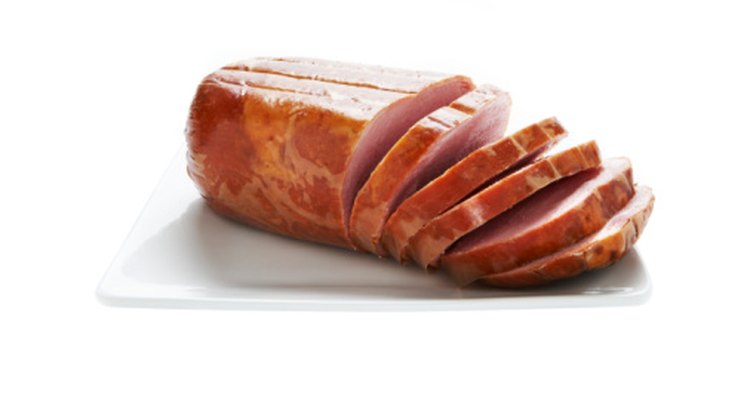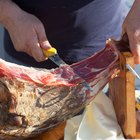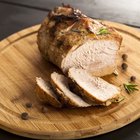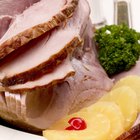
Whether you use an indoor rotisserie or one over an outside grill, the result is the same -- a delicious and juicy ham. By rotating your ham steadily, the rotisserie cooks your ham more evenly. The cooking process is slower and, as a result, your ham is juicier. If you’ve got the equipment, this is an ideal way to prepare a ham, but if you use an outdoor charcoal grill, you'll have to take extra steps to avoid cooking it by direct heat.
Prepare your ham by trimming away any excess rind or fat that will drip and cause spitting. Place a meat thermometer in the thickest part of the ham, then load it onto the spit. Depending on what kind of rotisserie you’re using, the manufacturer will include directions as to how to best do this. The process is generally as easy as inserting the spit through the center of the meat, then arranging the spit in the brackets to hold it. Some indoor models require that you place a pan beneath the ham to catch any drippings; even if you trim the ham well, there may be some.
Activate your rotisserie motor for medium heat. Rotate your ham over the heat for approximately 1½ hours for a 10-pound ham. Reduce the time accordingly for smaller hams, averaging about nine minutes per pound.
Remove the spit, with the ham, from your rotisserie after the required cooking time. Score the surface by creating hash marks with a paring knife. Insert cloves and coat the ham with the glaze of your choice. Empty out the drippings pan and replace it.
Return the spit and the ham to the rotisserie after glazing. Cook it for an additional half hour for a 10-pound ham, 15 minutes for a five-pound ham. The meat thermometer in a finished ham should register between 135 and 140 degrees Fahrenheit.
Related Articles

How to Cook a Boneless Ham on a ...

How to Cook a Ham: Removing the Skin

How to Smoke a Ham Shank on a Charcoal ...

How to Cook a Tavern Ham
How to Cook a Spiral Ham on the Gas ...

How to Slow-Cook a Pork Roast in a Pot ...
How to Cook a Ham With Brown Sugar, ...

How to Reheat a Ham
How Do I Cook a Black Forest Ham in a ...

How to Fully Cook a Hickory Smoked Ham

How Do I Roast a Picnic Ham?
Tips on How to Cook a Spiral Ham

How to Cook a Ham With Brown Sugar & ...

How Long to Cook a Suckling Pig on a ...

How to Bake a Juicy Tender Ham
How to Make Spiral Ham in Crock-Pot

How to Cook Prime Rib Using an Oven ...

How to Carve a Spiral Cut Ham

How to Cook Chicken Breasts in a ...
Can You Freeze a Spiral Ham?
References
Tips
- If you use a charcoal grill rotisserie, don't position your ham directly over the heat. Push the coals to the front or the back, and place the dripping pan directly beneath your meat.
- Use the first segment of cooking time to prepare your glaze. You can purchase a ready-made glaze, or make one of your own. Some ingredients that go well with ham include pineapple syrup, honey, cinnamon, ginger, and dry mustard. You can also use the pineapple slices to garnish your ham when it's finished.
Writer Bio
Beverly Bird has been writing professionally since 1983. She is the author of several novels including the bestselling "Comes the Rain" and "With Every Breath." Bird also has extensive experience as a paralegal, primarily in the areas of divorce and family law, bankruptcy and estate law. She covers many legal topics in her articles.
Photo Credits
Thomas Northcut/Digital Vision/Getty Images